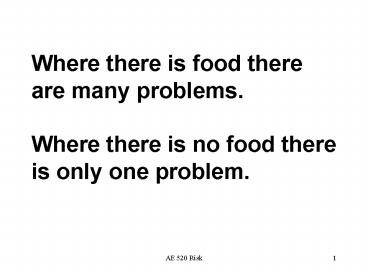Where there is food there are many problems' Where there is no food there is only one problem' - PowerPoint PPT Presentation
1 / 27
Title:
Where there is food there are many problems' Where there is no food there is only one problem'
Description:
Short-term bioassays using cell cultures ... This is the primary method used ... Toxicity levels for most chemicals are similar in humans and animals. ... – PowerPoint PPT presentation
Number of Views:64
Avg rating:3.0/5.0
Title: Where there is food there are many problems' Where there is no food there is only one problem'
1
Where there is food there are many
problems.Where there is no food there is only
one problem.
2
Conflicting Information about the Risk Caused by
Agricultural Chemicals comes from Differences of
Opinion on what is an Acceptable Risk
3
Current Cancer Risk
- 200000 people per million will die of cancer
(210)
4
EXAMPLES OF 1 per million CANCER RISK
- Living 20 days at sea level because of natural
background radiation - Living 2.5 months in a masonry house rather than
a wood frame house (added radiation from masonry) - Taking a round-trip coast-to-coast flight (added
radiation at high altitude.)
5
EXAMPLES OF 1 per million CANCER RISK
- Drinking 40 diet pops containing saccharin
- Smoking 2 cigarettes
- Eating 6 pounds of peanut butter (from aflatoxin
mold found in peanuts)
6
EXAMPLES OF 1 per million Death Risk in USA
- Every Day from Car Accidents
- Every 6 days from an ordinary fall
- Every 13 days from fire
7
PERCEIVED RISK
- LOW
- Voluntary Risk
- Natural Source
- Familiar Source
- Immediate Effect
- Continuous Exposure
- HIGH
- Involuntary Risk
- Synthetic Source
- Unfamiliar Source
- Delayed Effect
- Occasional Exposure
8
PERCEIVED RISK
- LOW
- Controllable Risk
- Clear Benefits
- Substance is necessary
- HIGH
- Uncontrollable Risk
- Unclear Benefits
- Substance is a luxury
9
ACCEPTABLE RISK DEFINED BY
- GUIDELINES (MCL, HA)
- ZERO TOLERANCE
- PROBABILITIES
10
WHAT IS THE RISK OF ONE TICKET WINNING THE
LOTTARY?
- 45 NUMBERS
- 6 NUMBERS PER TICKET
- HOW MANY COMBINATIONS OF 6 ARE POSSIBLE?
- 8,147,381
11
RISK ASSESSMENT
- Hazard Identification
- Dose-Response Assessment
- Human Exposure Assessment
- Risk Characterization
12
HAZARD IDENTIFICATION
- Is the particular substance toxic?
- Does it produce harmful effects?
- What is the nature of the harmful effects?
- cancer, cell mutations, damage to organs damage
to blood forming, nervous, or immune systems,
birth defects, damage to reproductive systems
13
SOURCES OF TOXIC DATA
- Epidemiology Studies (statistical cause-effect
studies) - Animal exposure studies
- Short-term bioassays using cell cultures
- Molecular structure analysis relate a chemical
to a chemical with similar molecular structure
with known toxicity.
14
EPIDEMIOLOGY STUDIES
- Case Control Studies Look at the commonalities
in past exposure that might account for everyone
in a group having a common health problem. - Everyone lived in the same community at some
time. - Everyone is a smoker
15
EPIDEMIOLOGY STUDIES
- Cohort Studies Look at a group of people with
similar exposure histories and compare their
health status. - Everyone exposed to agent orange
- Everyone who is a smoker
16
Characteristics of Epidemiology Studies
- Only direct measure of effects on human health
- Does provide information from actual exposure
- Accurate data on exposure levels is not readily
available - People frequently aren't aware of all their
exposure experiences
17
Characteristics of Epidemiology Studies
- Difficult to find a control group
- Difficult to sort out confounding exposure
- The absence of an effect does not guarantee that
there is no effect. - Differences in length of time of the exposure, or
the intensity of the exposure may effect the
results.
18
ANIMAL STUDIES TO DETERMINE TOXICITY
- This is the primary method used
- All chemicals that are carcinogenic to humans
have been found to cause cancer in at least some
animals - Toxicity levels for most chemicals are similar in
humans and animals. - At the cell level, humans and animals are very
similar
19
TYPES OF ANIMAL STUDIES
- Acute
- Oral (LD50)
- Dermal
- Inhalation(LC50)
- Chronic
- Teratogenic (birth defects) Mutagenic
- Primary skin irritation
- Skin Sensitization (allergies)
- Primary eye irritation
20
TYPES OF ANIMAL STUDIES
- Fertility and Reproductive
- Prenatal and Postnatal
- Multi-generational (3 generations)
21
LIMITATIONS OF ANIMAL STUDIES
- Differences between animals and humans
- weight, metabolic differences, Life span
differences - Differences between species
- Only about 30 of the chemicals that are
carcinogenic to mice are carcinogenic to rats,
and visa versa. - There is a lot of concern among animal rights
activists about animal studies.
22
SHORT TERM TESTS
- Rapid and inexpensive
- Designed to detect gene mutations
- Results not well correlated with animal studies
- Used for identification of carcinogens
- Not used to set standards
23
DOSE RESPONSE TESTING
- The response at very low dosage levels is not
known. - For carcinogens, there is no threshold level
assumed. - There are always cases of cancer in the check
group. Therefore it takes large numbers to
detect an increased rate of cancer due to any
particular cause.
24
DOSE RESPONSE TESTING
- Test are run at very high dosage levels and
mathematical models are used to extrapolate down
to normal exposure levels. The choice of the
mathematical model can make a big difference.
Different models can differ by a factor of 106 in
some cases. The linear multi-state model Take
the lowest point and draw a straight line from
there to 0. Add on a 95 Confidence interval and
use the upper limit of this.
25
TYPICAL DOSE-RESPONSE DATA SUMMARY
26
DIFFERENCES IN TOXICITY OF TCDD(dioxin) AMONG
DIFFERENT SPECIES
27
EPA IRIS Substance List
- Integrated Risk Information System
- www.epa.gov/ iris/ subst/ index.html

